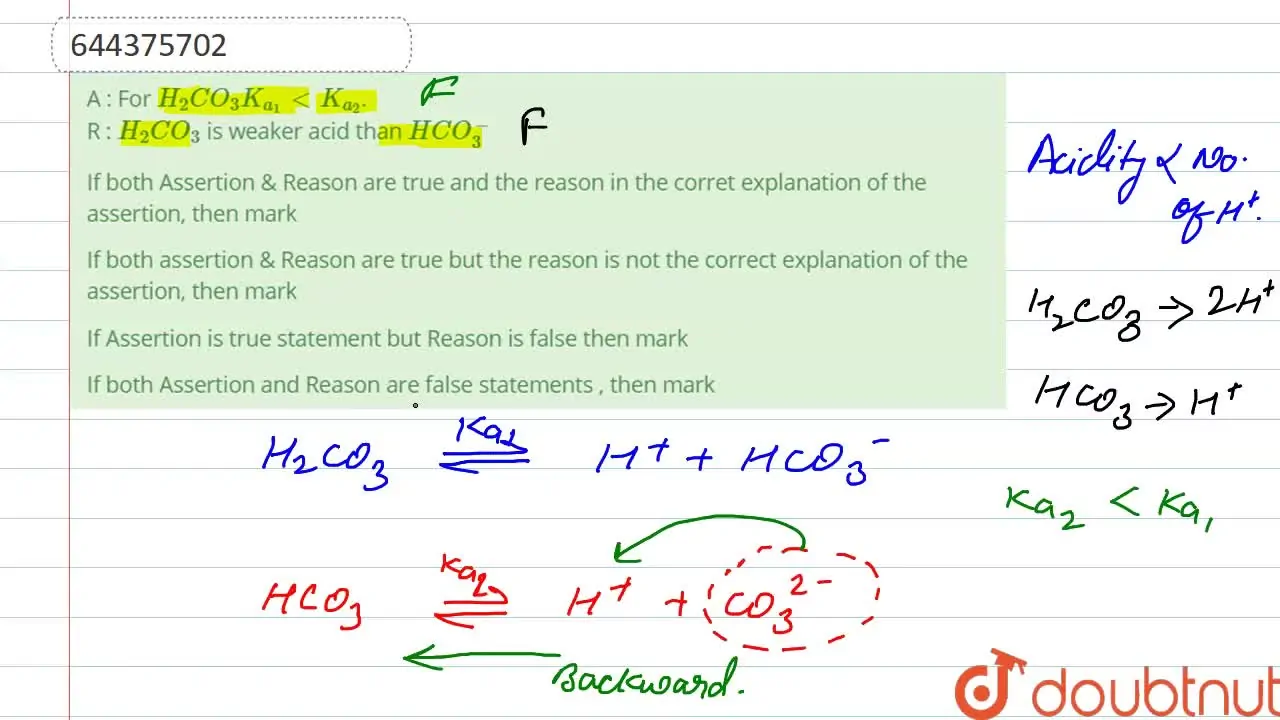A : For H2CO3Ka1<Ka2.
R : H2CO3 is weaker acid than HCO−3
If both Assertion & Reason are true and the reason in the corret explanation of the assertion, then mark
If both assertion & Reason are true but the reason is not the correct explanation of the assertion, then mark
If Assertion is true statement but Reason is false then mark
If both Assertion and Reason are false statements , then mark
The correct Answer is:D
Step by step video & image solution for A : For H_2CO_3 K_(a_1) lt K_(a_2). R : H_2CO_3 is weaker acid than HCO_3^- by Chemistry experts to help you in doubts & scoring excellent marks in Class 12 exams.
Related Playlists
- BOOK - AAKASH INSTITUTE ENGLISHCHAPTER - EQUILIBRIUMEXERCISE - ASSIGNMENT (SECTION -C)89videos
EQUILIBRIUM
- BOOK - AAKASH INSTITUTE ENGLISHCHAPTER - ENVIRONMENTAL CHEMISTRYEXERCISE - ASSIGNMENT (SECTION-D) (Assertion - Reason Type Questions)4videos
ENVIRONMENTAL CHEMISTRY
- BOOK - AAKASH INSTITUTE ENGLISHCHAPTER - GENERAL PRINCIPLES AND PROCESSES OF ISOLATION OF ELEMENTSEXERCISE - Assignment (Section-D) Assertion-Reason Type Question15videos
GENERAL PRINCIPLES AND PROCESSES OF ISOLATION OF ELEMENTS
Similar Questions
Statement-1: In CO2 molecule resonance is possible.
Statement-2: CO is used in purification of Ni.
Statement-3: H2CO3 is more acidic than H2SiO3.View SolutionSelect the correct sequence of events that occur during the delivery of O2 from blood to tissue
P : Absoption of CO2 by the blood
Q : Reaction of absorbed CO2 with H2O to form H2CO3– within RBC and its conversion into H+ and HCO3 ions
R : Reaction of absorbed CO2 with H2O in plasma to form H2CO3 and its conversion into H+ and HCO−3 ions.
S : Combination of H+ with heme portion of HbO2 to release O2
T : Combination of HCO−3 with heme portion of HbO2
to form reduced haemoglobin and release of O2View SolutionIf Ka1,Ka2 and Ka_3) be the first, second and third dissociation constant of H3PO4 and Ka1>>K2a>>Ka3 whis is/are correct :
View SolutionChoose the right sequential phenomena among following during the delivery of O2 from blood to tissue
P. Absorption of CO2 by the blood
Q. Reaction of absorbed CO2 with H2O to from H2CO3 within RBC and its conversion into H+ and HCO−3 ions
R. Reaction of absorbed CO2 with H2O in plasma to form H2CO3 and its conversion into H+ and HCO−3
S. Combination of H+ with haem portion of HbO2 to release O2
T. Comnbination of HCO−3 with haem portion HbO2 to form reduced haemoglobin and release of O2View SolutionHydrolysis is an acid-basedreaction of a cation or anion or both ions of a salt with water, Resultan solution of hydrolysis may be acidic, basic or netural. The anion A− which is a weakeer base than OH− and which his its conjugate acid HA stronger then water but weaker than H3O shown the phenomenon of hydrolysis Ex : CH3COO−,CN−,NO−2 etc.
The contion B+ which is a weaker acid than H+3 which is a weaker acid then H+3 and which has its conjugate base BOH stronger than water but weak than OH− shown the phenmenon of hydrolysis Ex : NH+4C6H5NH+,N2H+5 etc.
The hydrolysis constant of anion and cation are given by
A−(aq.)+H2O(l)⇔HA(aq.)+OH−(aq)
Kh=KwKa⇒[HA(aq.)][OH−(aq.)][A−(aq.)]
B+(aq.)+H2O(l)⇔BOH(aq.)+H+(aq.)
Kh=KwKb⇒[BOH(aq.)][H+(aq.)][B−(aq.)]
Calculate percentage degreeof hydrolysis in a 0.1 M solution of CH3COONa.(KaofCH3COOH=10−5)View SolutionpH = 7.4 , K1 of H2CO3 = 4.5 X 10−7 . What will be the ratio of [HCO−3] to [H2CO3]
View SolutionSTATEMENT-1: When 0.1 M weak diprotic acid H2A dissociated with its dissociation constants Ka1=10−3 and Ka2=10−8 , then [A2−] is almost equal to 10−3 M
STATEMENT-2: Since Ka2<<Ka1 for 0.1 M H2A,so[A2−] is negligible w.r.t. [HA−]View SolutionSTATEMENT-1: The dissociation constants of weak diprotic acid are in the order of Ka1>Ka2
STATEMENT-2: Removal of H+ from anion is difficult as compared to neutral molecule.View SolutionThe equilibrium constant of the following are :
N2+3H2⇔2NH3K1N2+O2⇔2NOK2H2+12O2→H2OK3
The equilibrium constant (K) of the reaction :
2NH3+52O2k⇐⇒2NO+3H2O, will be
(a)K1K33/K2
(b)K2K33/K1
(c)K2K3/K1
(d)K32K3/K1View SolutionCarbonic acid (H2CO3), a diprotic acid has Ka1=4.0×10−7 and Ka2=7.0×10−11. What is the [HCO−3] of a 0.025 M solution of carbonic acid?
View Solution


